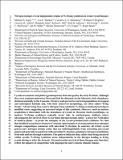Files in this item
Nitrogen isotopes reveal independent origins of N2-fixing symbiosis in extant cycad lineages
Item metadata
| dc.contributor.author | Kipp, Michael A | |
| dc.contributor.author | Stüeken, Eva E | |
| dc.contributor.author | Strömberg, Caroline A E | |
| dc.contributor.author | Brightly, William H | |
| dc.contributor.author | Arbour, Victoria M | |
| dc.contributor.author | Erdei, Boglárka | |
| dc.contributor.author | Hill, Robert S | |
| dc.contributor.author | Johnson, Kirk R | |
| dc.contributor.author | Kvaček, Jiří | |
| dc.contributor.author | McElwain, Jennifer C | |
| dc.contributor.author | Miller, Ian M | |
| dc.contributor.author | Slodownik, Miriam | |
| dc.contributor.author | Vajda, Vivi | |
| dc.contributor.author | Buick, Roger | |
| dc.date.accessioned | 2023-12-14T11:30:05Z | |
| dc.date.available | 2023-12-14T11:30:05Z | |
| dc.date.issued | 2023-11-16 | |
| dc.identifier | 297084967 | |
| dc.identifier | 8beb621b-f05d-438d-98c3-10a46c6b4360 | |
| dc.identifier | 37974002 | |
| dc.identifier | 85176764574 | |
| dc.identifier.citation | Kipp , M A , Stüeken , E E , Strömberg , C A E , Brightly , W H , Arbour , V M , Erdei , B , Hill , R S , Johnson , K R , Kvaček , J , McElwain , J C , Miller , I M , Slodownik , M , Vajda , V & Buick , R 2023 , ' Nitrogen isotopes reveal independent origins of N2-fixing symbiosis in extant cycad lineages ' , Nature Ecology and Evolution , vol. First Online . https://doi.org/10.1038/s41559-023-02251-1 | en |
| dc.identifier.issn | 2397-334X | |
| dc.identifier.other | Jisc: 1540729 | |
| dc.identifier.other | pii: 10.1038/s41559-023-02251-1 | |
| dc.identifier.other | ORCID: /0000-0001-6861-2490/work/148421664 | |
| dc.identifier.uri | https://hdl.handle.net/10023/28871 | |
| dc.description | Funding for isotopic analyses was provided by the University of Washington Royalty Research Fund and NASA Exobiology grant NNX16AI37G to R.B., as well as by a Paleontological Society student grant to M.A.K. | en |
| dc.description.abstract | Cycads are ancient seed plants (gymnosperms) that emerged by the early Permian. Although they were common understory flora and food for dinosaurs in the Mesozoic, their abundance declined markedly in the Cenozoic. Extant cycads persist in restricted populations in tropical and subtropical habitats and, with their conserved morphology, are often called ‘living fossils.’ All surviving taxa receive nitrogen from symbiotic N2-fixing cyanobacteria living in modified roots, suggesting an ancestral origin of this symbiosis. However, such an ancient acquisition is discordant with the abundance of cycads in Mesozoic fossil assemblages, as modern N2-fixing symbioses typically occur only in nutrient-poor habitats where advantageous for survival. Here, we use foliar nitrogen isotope ratios—a proxy for N2 fixation in modern plants—to probe the antiquity of the cycad–cyanobacterial symbiosis. We find that fossilized cycad leaves from two Cenozoic representatives of extant genera have nitrogen isotopic compositions consistent with microbial N2 fixation. In contrast, all extinct cycad genera have nitrogen isotope ratios that are indistinguishable from co-existing non-cycad plants and generally inconsistent with microbial N2 fixation, pointing to nitrogen assimilation from soils and not through symbiosis. This pattern indicates that, rather than being ancestral within cycads, N2-fixing symbiosis arose independently in the lineages leading to living cycads during or after the Jurassic. The preferential survival of these lineages may therefore reflect the effects of competition with angiosperms and Cenozoic climatic change. | |
| dc.format.extent | 12656217 | |
| dc.language.iso | eng | |
| dc.relation.ispartof | Nature Ecology and Evolution | en |
| dc.subject | GE Environmental Sciences | en |
| dc.subject | DAS | en |
| dc.subject.lcc | GE | en |
| dc.title | Nitrogen isotopes reveal independent origins of N2-fixing symbiosis in extant cycad lineages | en |
| dc.type | Journal article | en |
| dc.contributor.institution | University of St Andrews. School of Earth & Environmental Sciences | en |
| dc.contributor.institution | University of St Andrews. St Andrews Centre for Exoplanet Science | en |
| dc.identifier.doi | 10.1038/s41559-023-02251-1 | |
| dc.description.status | Peer reviewed | en |
This item appears in the following Collection(s)
Items in the St Andrews Research Repository are protected by copyright, with all rights reserved, unless otherwise indicated.

